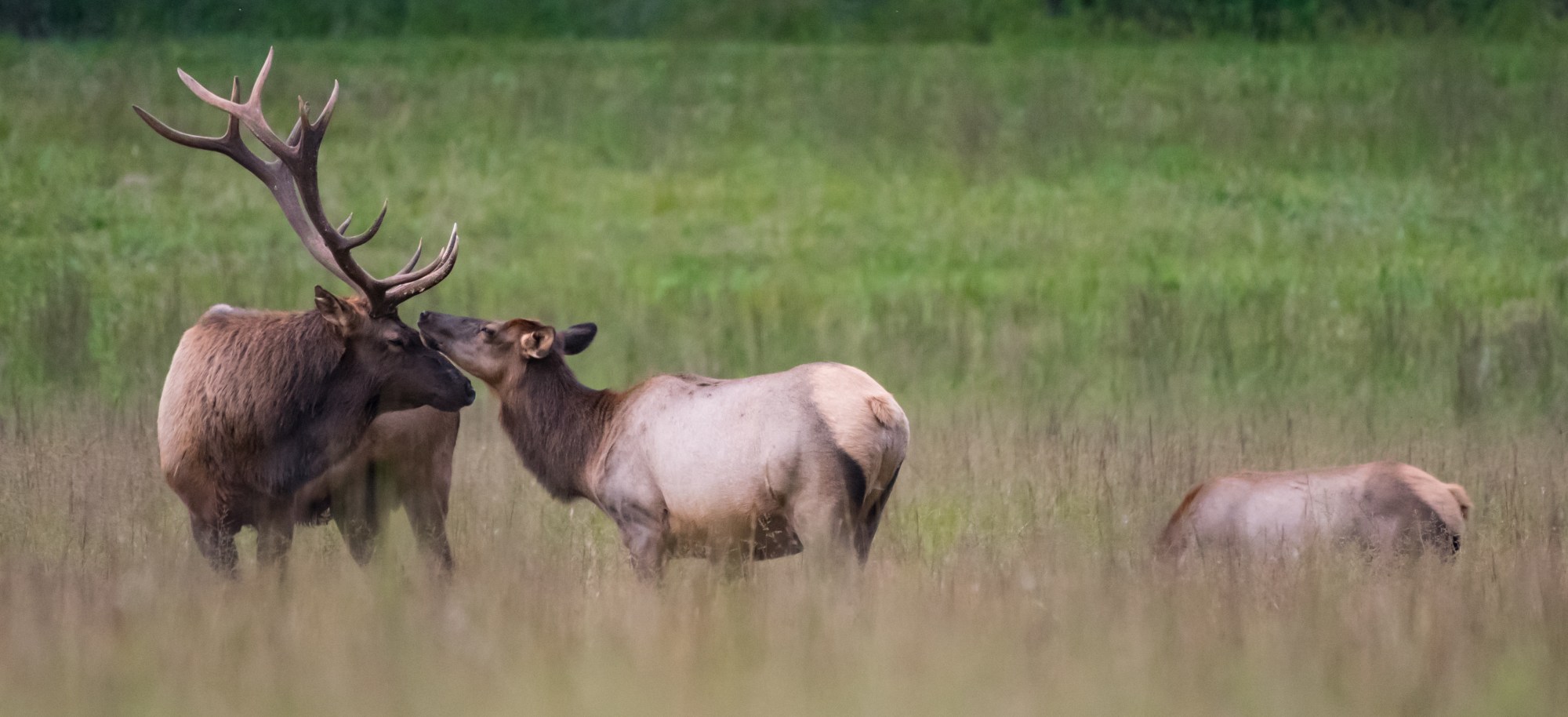The Smoky Mountain Elk Rut

by Lee Saunders, Travel Writer
You came early to drink and socialize. You look around. The competition hasn’t arrived. Then, there she is. She catches your eye from afar. Petite, gentle, somewhat coy, you approach and see if romance might be in the air. No, we are not talking about a bar in the hopping town of Asheville, North Carolina. We are talking about a scene that unfolded before my eyes in Great Smoky Mountains National Park, as one male elk – antlers in full bloom – approached a young female and bugled nature’s trumpet to show an interest in mating.
On my first ever trip to the western part of North Carolina, close to the Tennessee border, I felt privileged to learn of the tremendous reintroduction of the elk and be let briefly into the fascinating world of one of the largest land mammals around. Some early European explorers thought that the larger North American animal resembled a moose. But the elk are actually one of the largest species within the deer family. More Bambi than Bullwinkle.
As the rain briefly pelted down on our late summer evening drive to Cataloochee, I learned about how the larger elk species had suffered – particularly on the East coast – as the threats of British settlers, disease and hunting provided a deadly cocktail. While the eastern elk subspecies was driven to extinction in 1877, reintroduction programs of its close Canadian relatives have been successful. Now was my chance to see iconic “wapiti” getting frisky as mating season approaches. This was a far cry from Greater Manchester.
As we weaved down through mountain roads, that snaked one way, then stubbornly another, under a canopy of the tallest trees, before parking on the edge of wide open plain, on the edge of the woods. The younger, slender female elk, or cows, were there – six or so – sociable, but spread around, drinking nutrients from the ground. And there he was! Early for mating season. A giant bull in the center of the plain – wearing his majestic and proud antlers, which grow and are shed in response to the female’s presence. With a fully-grown bull weighing up to 1,000 pounds and standing up to 5 feet tall with another 3 feet in velvety antlers. He was stoic, calm, seemingly unflappable, moving slowly but deliberately towards his new friends. As the only male for the moment – mating season would be more prominent a month later in September– there was no antler wrestling (or sparring) yet, no clash of antlers as they fight for dominance and the right to mate with the whole harem of females.
And the story could have been so very different. By the late 15th century elk were the most widespread in the New World and could be found throughout what is now North America. In large numbers, elk once stretched from the Mississippi River across the Midwest and Southeast. When elk were becoming sparse, in the late 1800s, a public outcry led to the creation of Yellowstone National Park in Wyoming – a refuge for elk and the central focal point of repopulating the species. Another winding road brings us to year 2001 when Great Smoky Mountains National Park, at more than 520,000 acres, had enough suitable and remote land to support the elk’s reintroduction. With around $1 million raised by the Rocky Mountain Elk Foundation among others, and after nearly two decades of planning and hoping, it was all systems go! After two months in acclimatization pens, 25 Canadian elk, brought from the Kentucky-Tennessee border, were released into the eastern side of Great Smoky Mountains National Park in April 2001. Unsurprisingly, by June, eight were pregnant! Now the numbers exceed 200 and the elk have dispersed from Cataloochee into the Cherokee area, feeding on grasses, plants, leaves, and bark in woodlands, and grazing in the mornings and early evenings.
The Smoky Mountains have an intertwined history of Native Americans and early settlers, and there are amazing tales to hear about this period. There were once isolated yet thriving communities where the Park is now, before tourism took hold in the late 19th century as people grew increasingly drawn to the mineral rich mountain springs and a relaxing landscape outside of polluted cities.
In fact, Great Smoky National Park was opened in 1940, with $7 million in donations from John D. Rockefeller and the U.S. Congress. Today, the Appalachian Trail passes through the center of the park and in 2016 the National Park was the most visited in the country, with more than 11 million annual visitors. At the Park’s grand opening, President Franklin D. Roosevelt dedicated the park for the “permanent enjoyment of the people.” With this memorable Smoky Mountain Elk Tour by Asheville Hiking Tours, it has certainly worked.
Natural Notes is Asheville Hiking Tours’ blog about nature, history and travel in the Appalachians. Asheville Hiking Tours offers day hikes, waterfall tours, and firefly tours, guided by naturalists, in the mountains around Asheville, NC. For more info visit www.AshevilleHikingTours.com.
